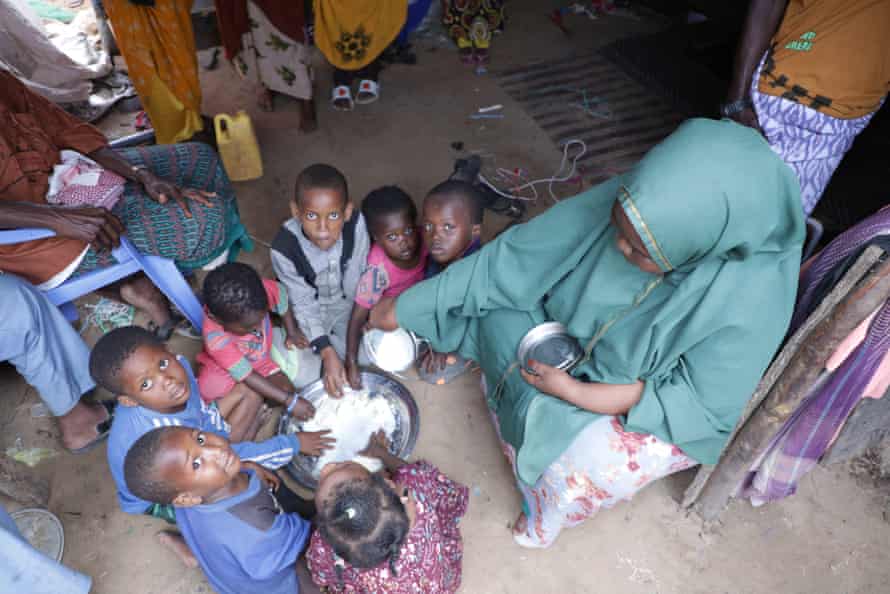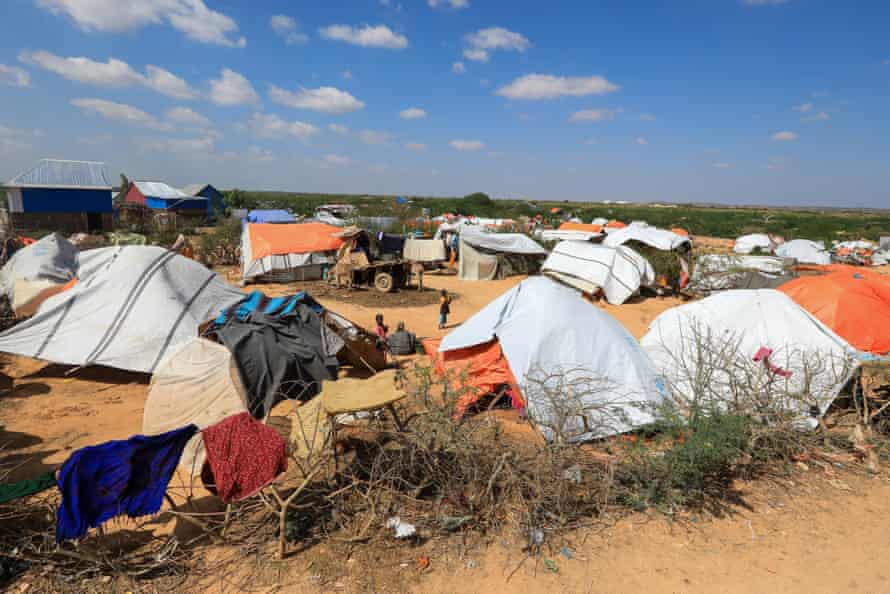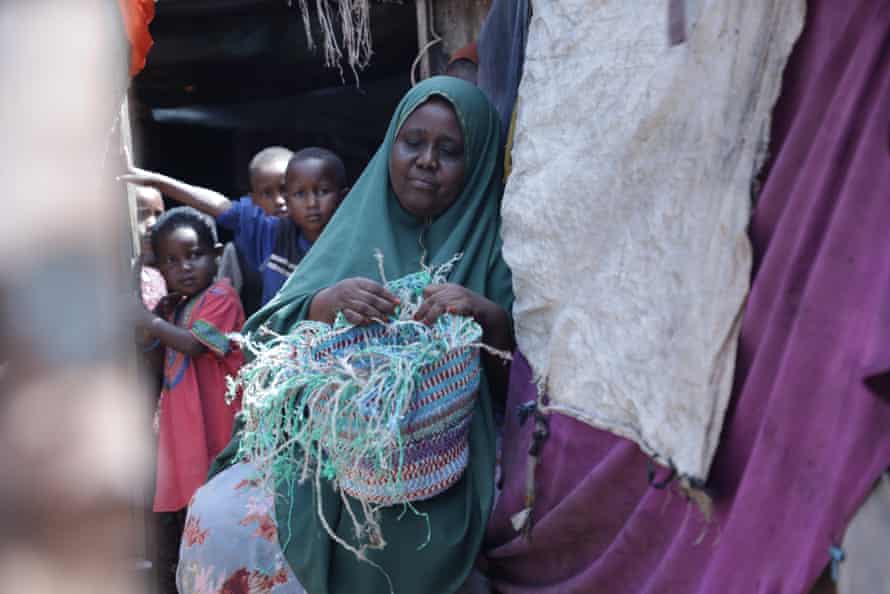‘Nothing to eat’: Somalia hit by triple threat of climate crisis, Covid and conflict
Overlapping crises have pushed the fragile east African country to the ‘cusp of humanitarian catastrophe’, with one in four facing food insecurity

Such was the horror that erupted in her village earlier this year that Fadumo Ali Mohamed decided she had no choice but to leave. Through the Lower Shabelle region of Somalia, she walked for 30 kilometres, along with her nine children, eventually getting help to reach the capital by car.
Now in Mogadishu, she is one of more than 800,000 internally displaced people (IDPs) in the capital living in cramped, informal settlements with limited access to food, water and healthcare. She doesn’t like to recall the violence she fled.
“Fighting between two clans erupted and we could not move anywhere for two days. My cousin and aunt died in the crossfire,” she says. “The warring militias blocked the wells; no one dared to get close to them, so I decided to escape with my children.”
They trekked through traumatic scenes of horror that turned their neighbourhood into a “ghost village”. “It was a nightmare that I hate to remember – burning houses and helpless people dying on the road,” she says. “They have been fighting for a long time, but it has got worse and worse recently.”
Prolonged droughts, shrinking water resources and lack of fertile land are fuelling tensions between clans and creating large-scale displacement across Somalia. A cluster of overlapping crises are menacing the fragile east African country, with the climate crisis exacerbating existing conflicts and contributing to new ones, Covid-19 claiming lives and livelihoods, and political instability never far away.
The result, warn humanitarian agencies, is hunger: the International Federation of Red Cross and Red Crescent Societies (IFRC) warned earlier this month that Somalia is “on the cusp of a humanitarian catastrophe”, with one in four people facing high levels of acute food insecurity and more than 800,000 children under the age of five at risk of acute malnutrition.
Mohammed Mukhier, IFRC’s regional director for Africa, says: “Somalia is one of the riskiest places on Earth to live right now. The country is a catalogue of catastrophes. Climate-related disasters, conflict and Covid-19 have coalesced into a major humanitarian crisis for millions of people. We can’t keep talking about this; we must reduce suffering now.”
For Mohamed, living in a small makeshift shelter with her children, managing to eat only once a day, the warning resonates. “We used to earn a living by washing clothes for people in the city, but when the [second wave of the] coronavirus began, everyone closed their doors,” she says. “Life became extremely difficult. We don’t have anything to eat.”

With a fragile economy largely based on agriculture, Somalia is vulnerable to increasingly erratic and extreme weather patterns, such as repeated droughts and seasonal floods. In the former, crops fail, and livestock die from lack of water and food; in the latter, they are simply washed away. Like much of the region, the country has also had to contend this year and last with swarms of desert locusts that consume approximately their own weight in fresh food every day.
Ahmed Yarow Ahmed, 50, fled the town of Rabdhure in the south-west Bakool region when his livestock were wiped out in the 2017 drought. One of Somalia’s 2.9 million displaced people, he has since been living in an IDP camp in the city of Baidoa.
“I had 70 goats and a farm and I have tried my best to make the most of the two,” says the father of nine children. “But I was forced to leave when the rains failed for three consecutive years and all of my livestock died.
“There are people who lost their lives. But life in the camps is not any better, because there is not enough food. There are vulnerable people here, including the elderly, women and unaccompanied children who have nothing to eat. We share the little we have with each other.
“There is no hope of returning to our homes any time soon because our lifestyle has completely changed and the rains are no longer reliable. We are now used to the city life. I want my children to get education and lead a better life.”

In June, the UN said Somalia was facing the worst funding shortage in six years. In an emergency appeal launched in July, the IFRC said it was seeking to raise GBP7m (8.7m Swiss francs) to support the Somali Red Crescent Society to deliver humanitarian assistance to people in Somaliland and Puntland over the next 18 months.
It warned that Covid was likely to lead to worsening nutrition among vulnerable groups, including poor households in urban areas and IDPs living in crowded, unhygienic conditions.
The pandemic has disrupted the Somali economy, which had been slowly recovering from years of conflict before Covid-19 hit. According to the World Bank, the economy contracted by 1.5% in 2020. The livestock sector, which makes up at least 40% of the country’s GDP, was particularly affected.
“I have lost almost 50% of my business since the pandemic started,” says Mohamed Awad from the port city of Bosaso, where most livestock is exported. “Saudi Arabia, which is our main export partner, has cancelled livestock imports, and other countries in the Middle East have also closed down their borders due to the disease.
“So it is not just me: this means a lot of people have lost their livelihoods, including the herders, the middlemen, the pastoralists … even the government’s income has been affected.”
None of this would be news to Fadumo Ali Mohamed. “We only eat once a day; water is for sale here and we cannot afford to pay for it,” she says. “My children’s father is sick and there is no access to medicine, so life is extremely difficult.”

This is not the first time Mohamed has been forced to flee her home of Balad Amin in Lower Shabelle. She was also in Mogadishu four years ago when the country was on the brink of famine.
“In 2017, we had to leave because there was no rain, no food and nothing else. Everyone was running to Mogadishu and I followed the people to save my children,” she says. But last year she was forcefully evicted from her shelter in an IDP camp in the capital’s Kahda district.
“The owners of the land came and evicted us from our settlement. We had nowhere else to go so we decided to return to our village, only to be forced back again by the fighting,” she says. “I gave up now. I will rather struggle to survive here than keep running around.”
